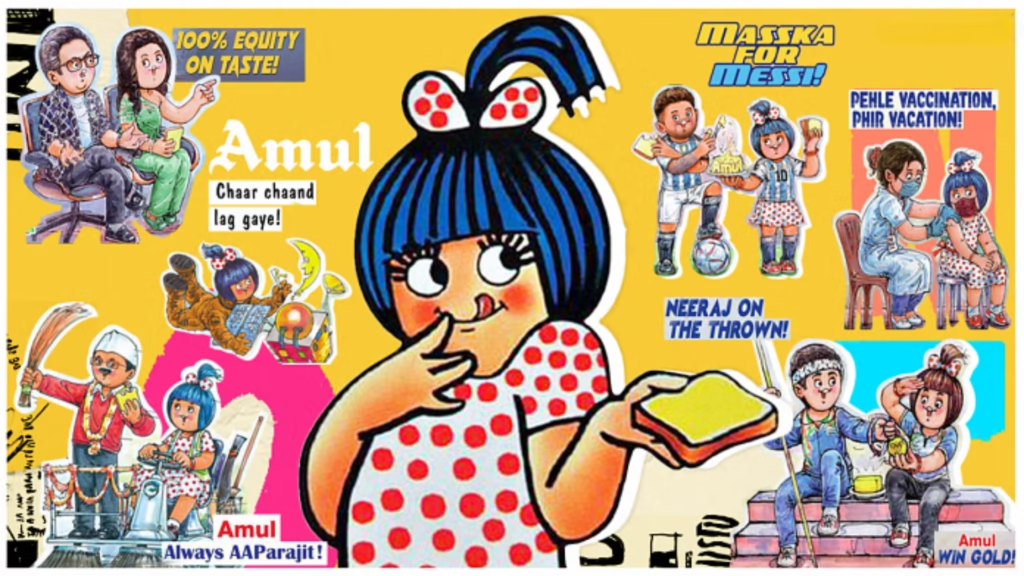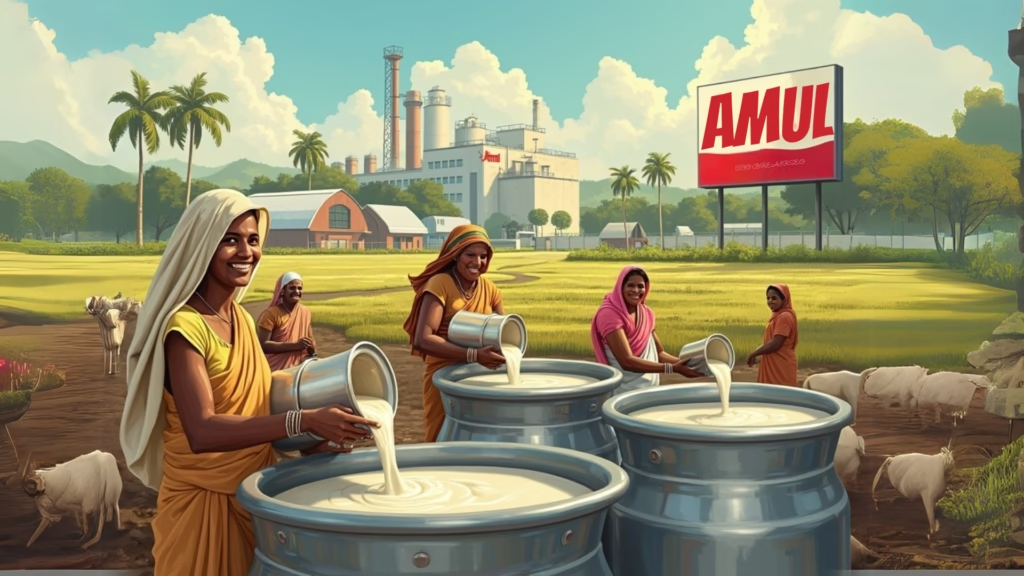In 1946, Amul sparked a remarkable cooperative movement in Anand, Gujarat, transforming India’s dairy industry to enhance rural livelihoods and boost milk production nationwide. Visionaries like Tribhuvandas Patel and Dr. Verghese Kurien drove this transformation, creating a network that empowered millions and set a benchmark for sustainable community-driven change.
Key Takeaways:
- Amul’s cooperative model, established in 1946, eliminated exploitative middlemen, ensuring farmers received fair compensation.
- With Dr. Verghese Kurien’s leadership, the White Revolution turned India into the top milk producer globally, with annual production skyrocketing from 21.2 million tonnes in 1968 to over 104 million tonnes by 2000.
- Amul’s three-tier cooperative structure provided farmers direct market access, enhancing control over pricing and production.
- Operation Flood, initiated by Amul in 1970, significantly boosted milk output, offering economic stability to over 16 million farmers.
- Through product diversification and innovative marketing, such as the famous ‘Amul Girl’ campaign, Amul maintained its competitive edge and cultural significance.
The White Revolution: Amul’s Impact on India’s Dairy Industry
In 1946, a significant journey began in Anand, Gujarat, where Amul was established to stand up against the exploitation of farmers by greedy middlemen. Led by Tribhuvandas Patel, with strong backing from figures like Sardar Vallabhbhai Patel and Morarji Desai, this cooperative movement was more than just a business—it was a mission inspired by India’s fight for independence. The aim was clear: ensure fair prices for farmers and restore their dignity and profit.
Fast forward to 1949, and Dr. Verghese Kurien, later celebrated as the Father of the White Revolution, joined this pioneering effort. Under his leadership, what started as a modest operation with just two village dairy societies processing 247 liters of milk, has transformed into a national network of 185,903 dairy cooperative societies. Together, these societies have revolutionized India’s dairy industry, ensuring farmers receive fair compensation and empowering rural communities across the country.
This journey wasn’t merely about milk; it was about creating a sustainable model that could uplift millions of lives, driven by the shared vision of a thriving and self-reliant India. The powerful legacy of Amul demonstrates the profound impact of community-driven change, fueled by unity and fairness.
Amul’s Key Role in India’s Cooperative Dairy Model
The core of Amul’s success lies in its cooperative model. It allowed farmers to own a stake in the business, ensuring that profits went back to these grassroots contributors. This inclusive approach led to increased income and improved standards of living for countless families.
Amul’s influence spearheaded the White Revolution, a term synonymous with India’s milestone dairy transformation. This initiative, set into motion in the 1970s, aimed at increasing milk production and elevating India onto the global stage as a leading milk producer. The White Revolution dramatically boosted milk output from 21.2 million tonnes in 1968 to over 104 million tonnes by the year 2000, a testament to the efficacy of Amul’s cooperative model. This effort turned India into the largest milk producer in the world, surpassing the United States in production by 1998 according to the National Dairy Development Board.
Amul’s journey, driven by visionary leaders and an innovative cooperative system, is a classic example of how structured, community-focused efforts can drive significant economic and social change.
The Amul Model: A Cooperative Success
The Amul model stands out with its unique three-tier system, which is pivotal for how India achieved its status as the world’s largest milk producer. At its core, the model is about building a robust network involving village-level dairy cooperatives, district milk unions, and state federations. Let’s delve into each tier for a clearer understanding.
The Three-Tier Structure of the Amul Model
- Village-Level Dairy Cooperatives: This foundational tier consists of small farmers who directly contribute milk. These cooperatives form the backbone of the system, ensuring that milk is collected efficiently and fairly.
- District Milk Unions: This second layer aggregates milk from the village cooperatives. It handles processing and packaging, ensuring quality and compliance with safety standards.
- State Federations: At the top tier, these federations manage marketing and distribution. They ensure that branded products reach consumers across the nation, helping maintain competitiveness in the market.
This structured approach has been crucial in reaching out to over 16 million farmers who are now part of this expansive cooperative.
Farmers’ Empowerment through Ownership
One of the extraordinary aspects of the Amul model is that it empowers farmers by allowing them ownership of the cooperative. Because they own the cooperative, farmers share in the profits, which translates into genuine economic empowerment. There are a few significant benefits for farmers:
- Shared Profits: The cooperative ensures that profits are distributed back to the farmers, increasing their income and securing their livelihood.
- Economic Empowerment: Owning part of the cooperative gives farmers a voice in decisions, promoting a sense of ownership and engagement.
It’s this combination of structural efficiency and farmer empowerment that has truly made the Amul model instrumental in transforming India’s dairy industry. It’s not just about producing milk but fostering a model that uplifts an entire community, enhancing both economic and social well-being.
Product Diversification and Technological Advancements
Amul has diversified its product range to cater to India’s varied tastes. Their lineup extends far beyond milk and butter to include cheese, yogurt, and even chocolates. Not only does this meet consumer demand, but it also enhances the company’s market reach, offering something for every palate.
Moreover, Amul’s use of technology has significantly enhanced their efficiency. With advancements in cold storage and transportation, they ensure products remain fresh from farm to table. According to a report by Economic Times, implementing automated processes has substantially reduced wastage, further positioning Amul as a leader in the dairy sector.
Amul Girl Campaign: A Marketing Masterstroke
The Amul Girl campaign is iconic, serving as a brilliant marketing tool. This witty mascot, launched in 1967, offers a playful way to comment on current events through ads. The campaign remains relevant due to its clever play on words and topical themes.
- Topical Themes: The campaign comments on weekly news, engaging audiences with humor and relevance.
- Long-standing Legacy: It has run for over five decades, earning a place in India’s advertising hall of fame, recognized by the Indian Society of Advertisers.
Amul’s efforts in product diversification, technological advancements, and creative marketing have transformed India’s dairy industry. By consistently aligning product development and marketing strategies with consumer needs, they’ve ensured sustained growth and brand loyalty over time.

Socio-Economic Impact of Amul’s Model
Boosted Incomes of famers
Amul’s success story inspired a ripple effect across India, encouraging the formation of new dairy cooperatives. These cooperatives have significantly improved incomes for countless farmers. By pooling resources and providing fair prices, farmers have been able to improve their financial stability. The increase in dairy production that followed has helped lift many from poverty, creating an economic safety net. As more farmers reap these benefits, their standard of living improves, providing them with opportunities they may not have previously imagined.
Established a Global Model
The increase in milk production has not just filled pockets; it has nourished bodies too. With more accessible and affordable milk, nutritional standards have risen for millions of people across India. Milk, rich with essential nutrients like calcium and protein, is vital for growth and health, especially in children. Amul’s model didn’t just stop there; it gained global recognition as a shining example of cooperative economics. This approach, where goals and profits are shared, has been studied and praised for its equitable impact on communities. By fostering a sense of ownership among farmers, the model continues to set a benchmark for success in collective entrepreneurship.
Want to Read Another Inspiring Business Journey?
Amul’s success story is a testament to how innovation and perseverance can transform an industry. But it’s not the only Indian brand that has made a global impact. Discover how Haldiram’s, a humble namkeen brand, expanded its reach worldwide and became a household name in the snack industry. Read the full story here: The Inspiring Story of Haldirams
Stay tuned to know how Amul countered the challenges of Managing Logistics and maintaining quality!
Sources:
Amul – About Us
Amul’s White Revolution
Amul Milk Launches in US
Amul Case Study – History & Future
Drishti IAS – Amul a Pillar of India’s Dairy Sector
Case Study on Amul
History Of Amul – Valorealm
How Amul Changed India’s Dairy Industry
Amul Company History – Yubi



